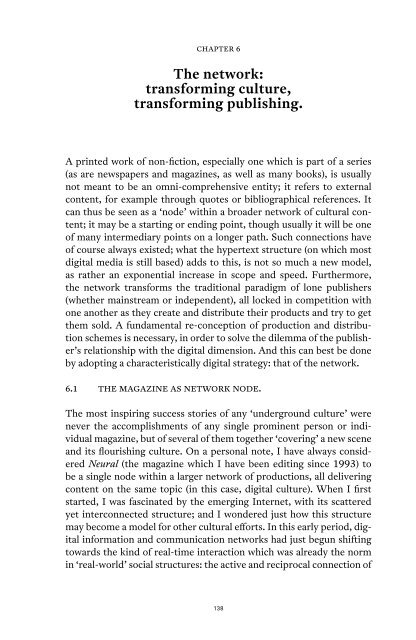Post- Digital Print - Monoskop
Post- Digital Print - Monoskop
Post- Digital Print - Monoskop
You also want an ePaper? Increase the reach of your titles
YUMPU automatically turns print PDFs into web optimized ePapers that Google loves.
chapter 6<br />
The network:<br />
transforming culture,<br />
transforming publishing.<br />
A printed work of non-fiction, especially one which is part of a series<br />
(as are newspapers and magazines, as well as many books), is usually<br />
not meant to be an omni-comprehensive entity; it refers to external<br />
content, for example through quotes or bibliographical references. It<br />
can thus be seen as a ‘node’ within a broader network of cultural content;<br />
it may be a starting or ending point, though usually it will be one<br />
of many intermediary points on a longer path. Such connections have<br />
of course always existed; what the hypertext structure (on which most<br />
digital media is still based) adds to this, is not so much a new model,<br />
as rather an exponential increase in scope and speed. Furthermore,<br />
the network transforms the traditional paradigm of lone publishers<br />
(whether mainstream or independent), all locked in competition with<br />
one another as they create and distribute their products and try to get<br />
them sold. A fundamental re-conception of production and distribution<br />
schemes is necessary, in order to solve the dilemma of the publisher’s<br />
relationship with the digital dimension. And this can best be done<br />
by adopting a characteristically digital strategy: that of the network.<br />
6.1 the magazine as network node.<br />
The most inspiring success stories of any ‘underground culture’ were<br />
never the accomplishments of any single prominent person or individual<br />
magazine, but of several of them together ‘covering’ a new scene<br />
and its flourishing culture. On a personal note, I have always considered<br />
Neural (the magazine which I have been editing since 1993) to<br />
be a single node within a larger network of productions, all delivering<br />
content on the same topic (in this case, digital culture). When I first<br />
started, I was fascinated by the emerging Internet, with its scattered<br />
yet interconnected structure; and I wondered just how this structure<br />
may become a model for other cultural efforts. In this early period, digital<br />
information and communication networks had just begun shifting<br />
towards the kind of real-time interaction which was already the norm<br />
in ‘real-world’ social structures: the active and reciprocal connection of<br />
138

















